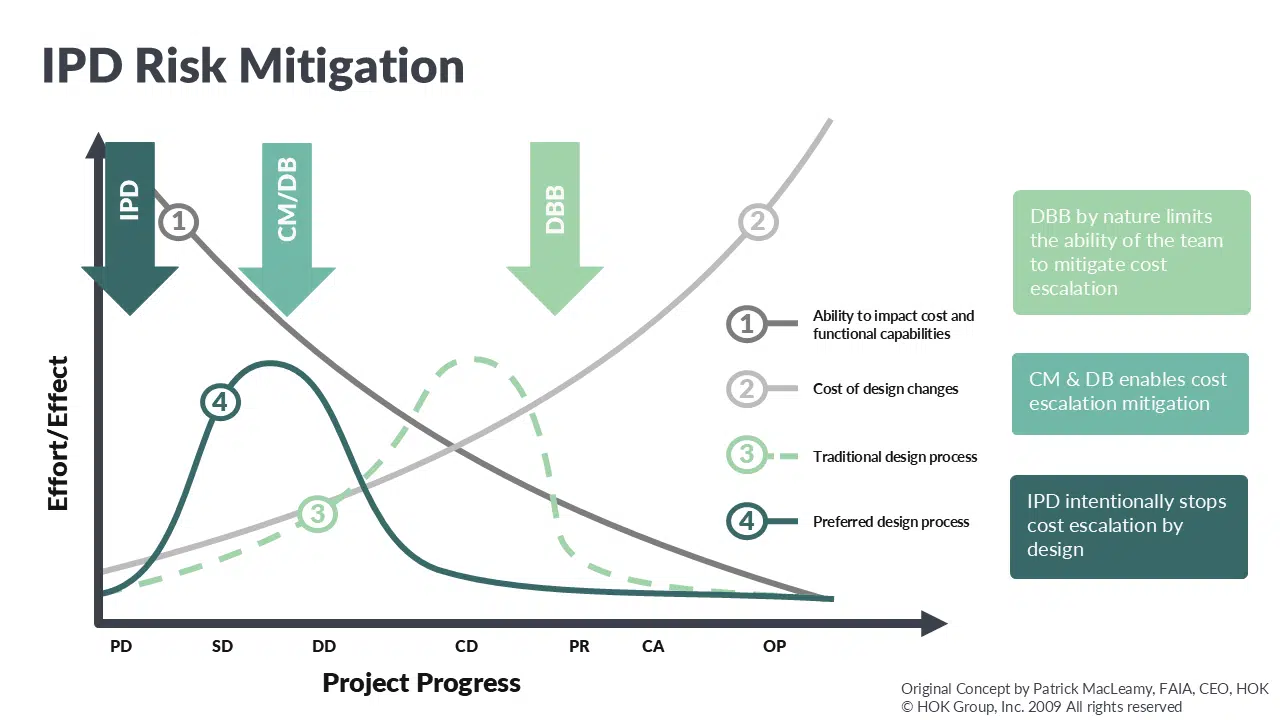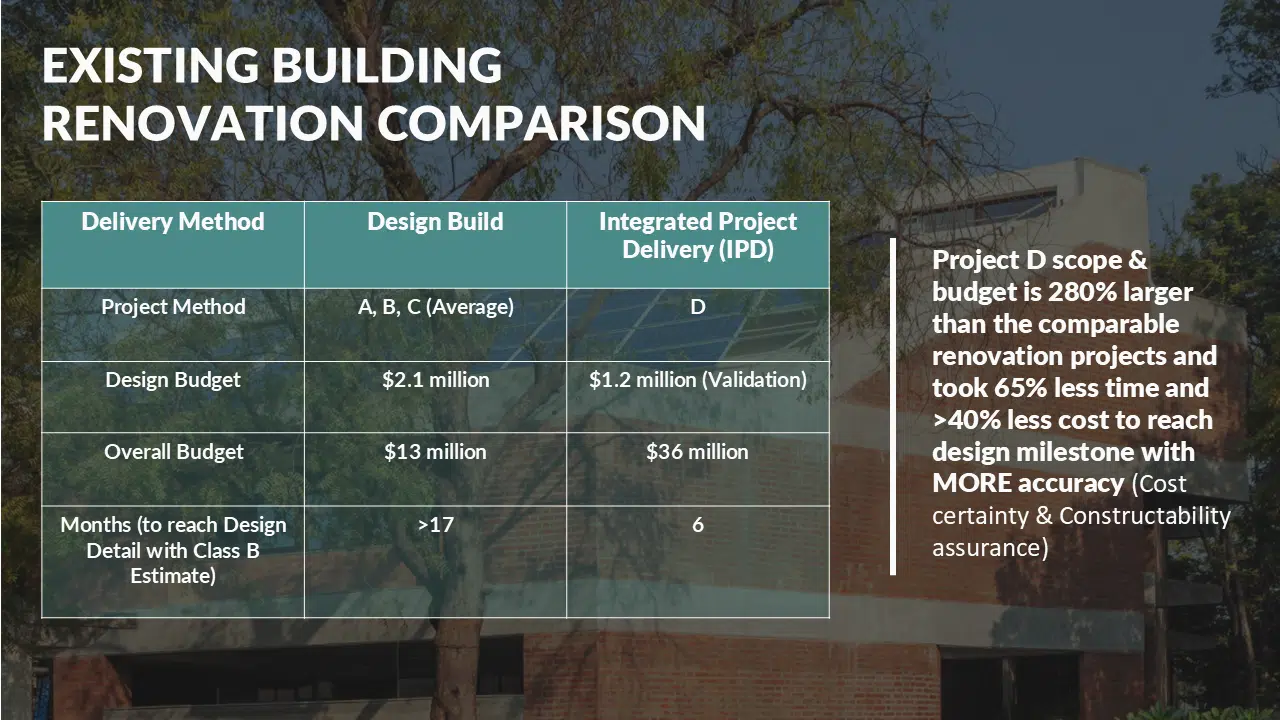One of the biggest levers we have to mitigate climate change is through decarbonizing existing buildings; however, it can be complex and costly. How can owners and project teams navigate existing building retrofit challenges and improve project outcomes?
Stok’s half-day summit, Decarbonize Now with Collaborative Project Delivery, features owner representatives from across North America sharing how they retrofitted their existing buildings within budget with collaborative project delivery.
If you aren’t familiar with this project delivery method yet, welcome to Collaborative Project Delivery 101!
WHY CHOOSE COLLABORATIVE PROJECT DELIVERY?
Given 70% of conventional building projects are over budget and behind schedule, it’s clear we need a better way to bring the vision to reality. Luckily, collaborative project delivery offers a solution.
On average, the Integrated Project Delivery (IPD) and Lean construction process results in:
-
-
- 74% ahead of schedule
- 64% greater profitability/reduced costs
- 77% improved safety
- 80% greater customer satisfaction
-
While data does not ensure IPD will keep your project on schedule and under budget, the delta between conventional and IPD results is a significant improvement that mitigates risk for owners and project teams.
WHAT IS COLLABORATIVE PROJECT DELIVERY?
So, what is it exactly? Collaborative project delivery is a delivery method that includes all team members at the start of the project to mitigate risk for the owner, the project, and the team as a whole, delivering a higher quality, more sustainable project within budget and on schedule.
It is a better process, by design.
HOW DOES COLLABORATIVE PROJECT DELIVERY WORK?
Early engagement to mitigate cost escalation and deliver value

Consider the timeline of a project. As illustrated by the MacLeamy curve, the costs of design changes escalate as the project progresses further.
Collaborative project delivery intentionally mitigates cost escalation by design by engaging the full team earlier when changes cost the least. Notably different from Design-Bid-Build projects, the general contractor and trades are invited earlier to add real time market cost and constructability to design solutions. The construction team has the largest impact on project outcomes and having their say at the start mitigates changes orders.
Upfront validation to improve cost certainty and mitigate risk
Lean construction is the operating system behind the IPD delivery process. The validation phase of a project is equivalent to the “fail fast” concept of the “lean startup”. This Lean approach focuses teams on delivering value to the customer, which in IPD means validating if the client can build the proposed building within the proposed budget and schedule. To achieve this target value delivery goal, teams only design enough to confirm pricing and schedule impacts. The results of this fail fast lean targeted approach is that projects achieve a design milestone in less time with more constructability and cost certainty.

The image above summarizes a comparison of four retrofit projects concurrently executed by the City of Edmonton. Three of the four were delivered with Design Build and one with IPD; the results speak for themselves.
HOW DOES COLLABORATIVE PROJECT DELIVERY HELP TEAMS DECARBONIZE NOW?
The original co-creators IPD intended to ensure sustainability goals are baked into the IPD process. What does this look like?
The right people involved up front and at the right time.

Compared to a conventional process, where sustainability initiatives are often cut out when a project goes to market and is over budget, the IPD process contractually requires teams to deliver ‘conditions of satisfaction’ for a client, which in essence is what the client values – not more, not less. The early validation phase provides time for the team to run scenarios to design to fit this value in the clients’ budget and cut out all non-value items.
In conventional delivery, design is siloed, decarbonization goals are often calculated based on default data, and the business case may not be reached. Contrarily, in IPD, working with the specialty trades allows decarbonization goals to be calculated with all perspectives, costs, and innovative solutions considered, capturing sustainability initiatives within the project budget.
Through this process, owners can fit sustainability strategies into capital costs up front, no longer only benefiting from long-term ROI. Past project data indicates that on average, the majority of projects delivered through IPD are under budget, and are able to add more value within that budget for clients, meaning more budget that can be invested in what matters, like sustainability outcomes to achieve decarbonization goals.
WANT MORE?
Wondering what this all looks like in action? Have questions for owners who’ve had success on collaborative delivery projects?
Stok’s half-day virtual summit, Decarbonize Now with Collaborative Project Delivery, provides answers. Speaking to case studies of small- and large-scale single building and portfolio-level retrofits, experts at Edmonton Public Schools, District of Squamish, City of Edmonton, and Reos Partners (who developed the Empire Building Playbook), join Stok to share their successes and lessons learned with collaborative project delivery retrofits.
Watch now for owner-to-owner inspiration on how to decarbonize your existing buildings within budget with collaborative project delivery.



